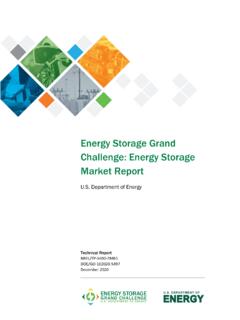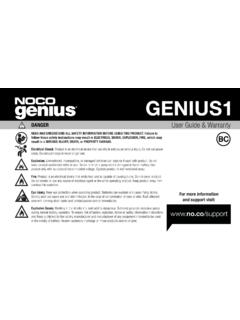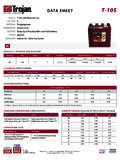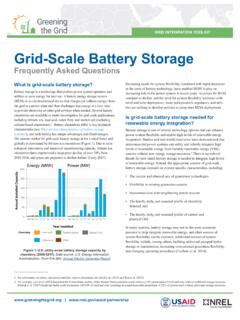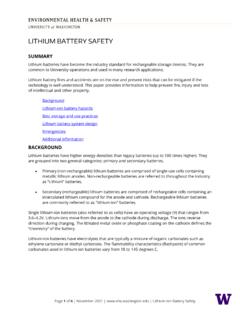Transcription of Economic Analysis Case Studies of Battery Energy Storage ...
1 NREL is a national laboratory of the Department of Energy Office of Energy Efficiency & Renewable Energy Operated by the Alliance for Sustainable Energy , LLC This report is available at no cost from the National Renewable Energy Laboratory (NREL) at Contract No. DE-AC36-08GO28308 Economic Analysis Case Studies of Battery Energy Storage with SAM Nicholas DiOrio, Aron Dobos, and Steven Janzou National Renewable Energy Laboratory Technical Report NREL/TP-6A20-64987 November 2015 NREL is a national laboratory of the Department of Energy Office of Energy Efficiency & Renewable Energy Operated by the Alliance for Sustainable Energy , LLC This report is available at no cost from the National Renewable Energy Laboratory (NREL) at Contract No.
2 DE-AC36-08GO28308 National Renewable Energy Laboratory 15013 Denver West Parkway Golden, CO 80401 303-275-3000 Economic Analysis Case Studies of Battery Energy Storage with SAM Nicholas DiOrio, Aron Dobos, and Steven Janzou National Renewable Energy Laboratory Prepared under Task No. SS139001 Technical Report NREL/TP-6A20-64987 November 2015 NOTICE This report was prepared as an account of work sponsored by an agency of the United States government. Neither the United States government nor any agency thereof, nor any of their employees, makes any warranty, express or implied, or assumes any legal liability or responsibility for the accuracy, completeness, or usefulness of any information, apparatus, product, or process disclosed, or represents that its use would not infringe privately owned rights.
3 Reference herein to any specific commercial product, process, or service by trade name, trademark, manufacturer, or otherwise does not necessarily constitute or imply its endorsement, recommendation, or favoring by the United States government or any agency thereof. The views and opinions of authors expressed herein do not necessarily state or reflect those of the United States government or any agency thereof. This report is available at no cost from the National Renewable Energy Laboratory (NREL) at Available electronically at SciTech Connect Available for a processing fee to Department of Energy and its contractors, in paper, from: Department of Energy Office of Scientific and Technical Information Box 62 Oak Ridge, TN 37831-0062 OSTI Phone: Fax: Email: Available for sale to the public, in paper, from: Department of Commerce National Technical Information Service 5301 Shawnee Road Alexandria, VA 22312 NTIS Phone: or Fax: Email: Cover Photos by Dennis Schroeder.
4 (left to right) NREL 26173, NREL 18302, NREL 19758, NREL 29642, NREL 19795. NREL prints on paper that contains recycled content. iii This report is available at no cost from the National Renewable Energy Laboratory (NREL) at Executive Summary Behind-the-meter electric- Energy Storage has been considered recently as a possible means of enabling higher amounts of renewable Energy on the grid. States such as California have introduced mandates and subsidies to spur adoption. This work considers customer sited behind-the-meter Storage coupled with photovoltaics (PV) and presents case Studies of the financial benefit of customer-installed systems in California and Tennessee.
5 Different dispatch strategies, including manual scheduling and automated peak-shaving were explored to determine ideal ways to use the Storage system to increase the system value and mitigate demand charges. Incentives, complex electric tariffs, and site-specific load and PV data were used to perform detailed Analysis using the free, publicly available System Advisor Model (SAM) tool. We find that installation of photovoltaics with a lithium-ion Battery system in Los Angeles and installation of lithium-ion batteries without photovoltaics in Knoxville yields positive net-present values considering high demand charge utility rate structures, Battery costs of $300/kWh, and dispatching the batteries using perfect day-ahead forecasting.
6 All other scenarios considered cost the customer more than the savings accrued. General conclusions about influential factors in determining net present value remain elusive because our Analysis shows high sensitivity of Battery economics to the complex interplay among scenario parameters and location-specific information. iv This report is available at no cost from the National Renewable Energy Laboratory (NREL) at Table of Contents Executive Summary .. iii 1 Introduction .. 1 2 Methods and Data .. 3 Weather and Load data .. 3 Dispatch control strategies .. 4 Manual dispatch controller .. 4 Automated dispatch controller .. 4 PV System .. 5 Batteries.
7 5 Lithium-Ion .. 5 Lead acid .. 6 Los Angeles System .. 7 Facility .. 7 Utility rate structure .. 7 System configuration .. 8 Incentives .. 8 Knoxville System .. 8 Facility .. 8 Utility rate structure .. 8 System configuration .. 8 Incentives .. 9 System Costs and Financial Parameters .. 9 Financial metrics .. 10 Net Present Value .. 10 Payback Period .. 10 3 Results and Discussion .. 12 Varying Battery Bank Size .. 12 Varying Battery Chemistry .. 13 Varying Storage Dispatch .. 13 Best Case Summary .. 14 4 Conclusions .. 15 1 This report is available at no cost from the National Renewable Energy Laboratory (NREL) at 1 Introduction Mandates for Energy Storage coupled with incentives and the high-profile introduction of batteries for behind-the-meter Storage applications have led to an increased need for tools and Analysis that evaluates financial benefit under various scenarios.
8 In 2010 the California Public Utilities Commission released a target of gigawatts (GW) of Energy Storage in the state by 2020 [1]. The GW target is broken up between the public utilities Pacific Gas & Electric (PG&E), Southern California Edison (SCE) and San Diego Gas & Electric (SDG&E). Each has specific procurement targets for transmission, distribution and customer-sited Storage . Statewide, the customer-sited Storage target totals 200 megawatts (MW). California has also instituted an incentive program for Energy Storage projects through its Self-Generation Incentive Program (SGIP) [2]. 2014 incentive rates for advanced Energy Storage projects were $ for systems with up to 1 MW capacity, with declining rates up to 3 MW.
9 ConEdison in New York State also provides an incentive of $ for Battery Energy Storage projects completed prior to June 1, 2016 [3]. Elsewhere, other states such as Hawaii have Energy Storage demonstration projects in progress [4]. Incentives offer additional financial benefit to Energy Storage systems, but the systems must serve an ongoing role in providing value to customers to justify the capital expenditure. For behind-the-meter applications, the reduction of demand charges is one way that these systems reduce commercial customer bills. A previous study [5] used the Battery Lifetime Analysis and Simulation Tool (BLAST) developed at the National Renewable Energy Laboratory (NREL) to consider optimizing the size and operation of an Energy Storage system providing demand charge management.
10 Battery degradation and capital replacement costs were not considered. This study will similarly conduct demand charge management Analysis , but will focus on two specific scenarios using NREL s freely-available System Advisor Model (SAM) tool. SAM links a high temporal resolution PV-coupled Battery Energy Storage performance model to detailed financial models to predict the Economic benefit of a system. The Battery Energy Storage models provide the ability to model lithium-ion or lead- acid systems over the lifetime of a system to capture the variable nature of Battery replacements. Additional value streams such as using Storage to provide ancillary services within California Independent System Operator s (CAISO) or other markets are not considered here.










